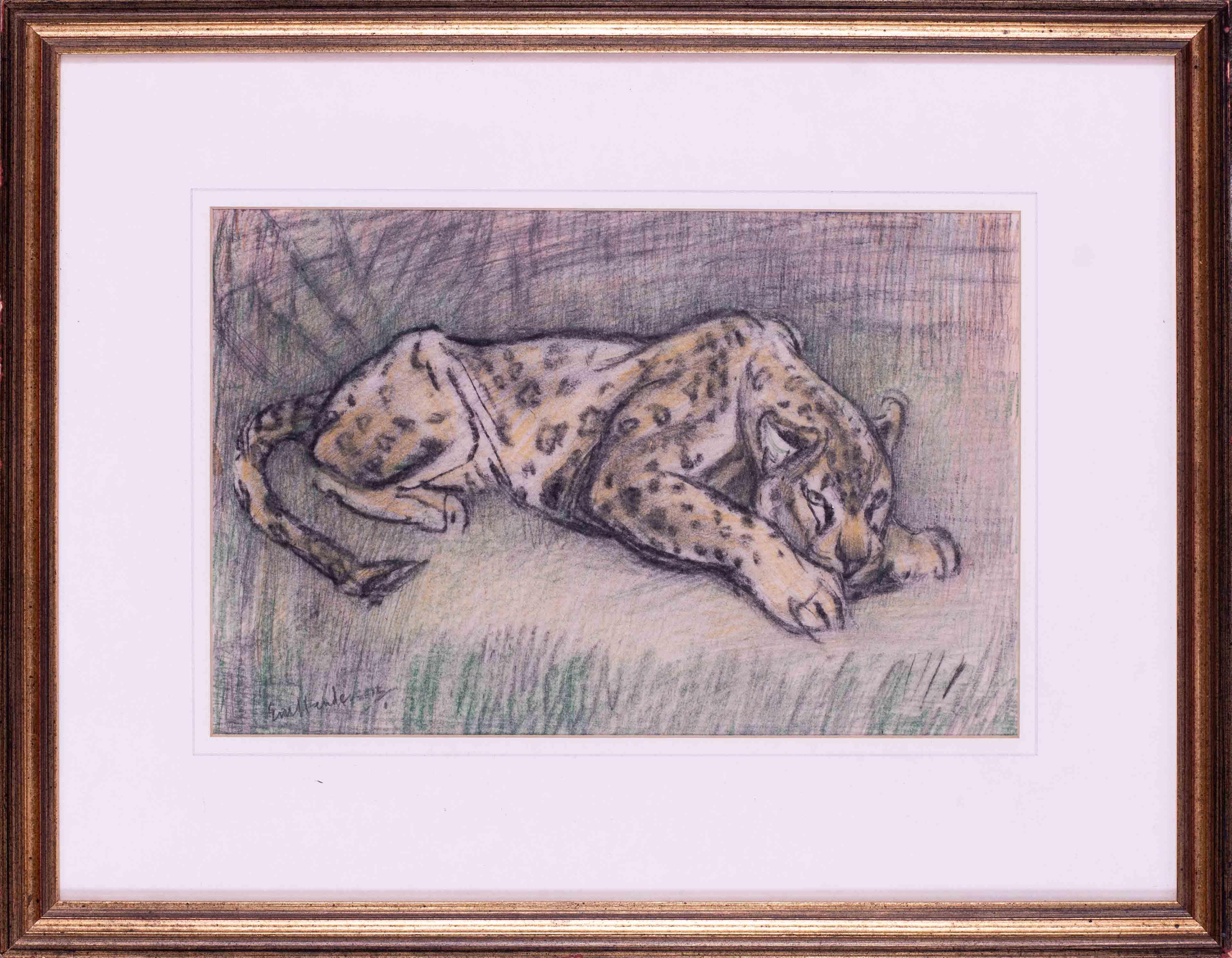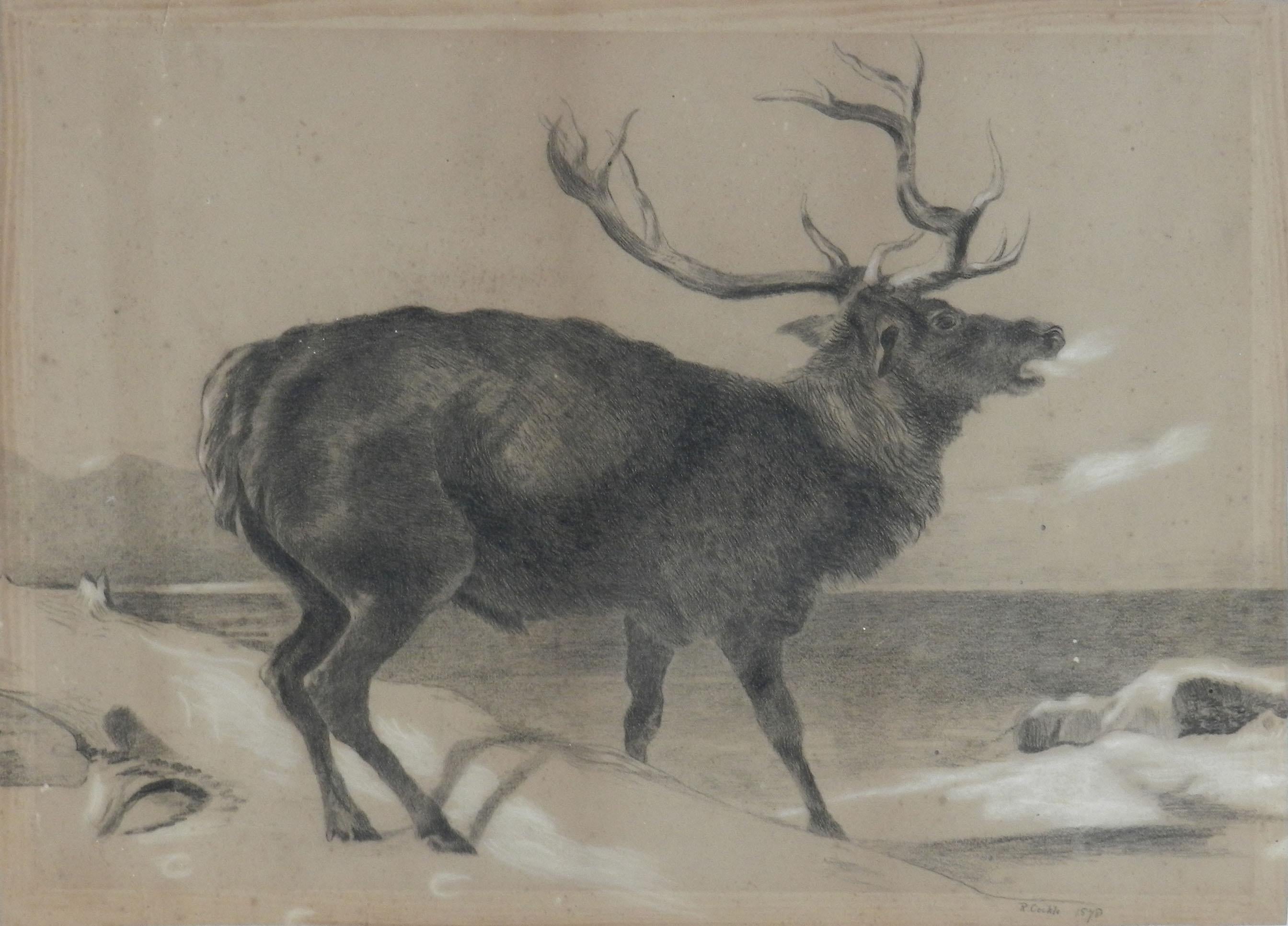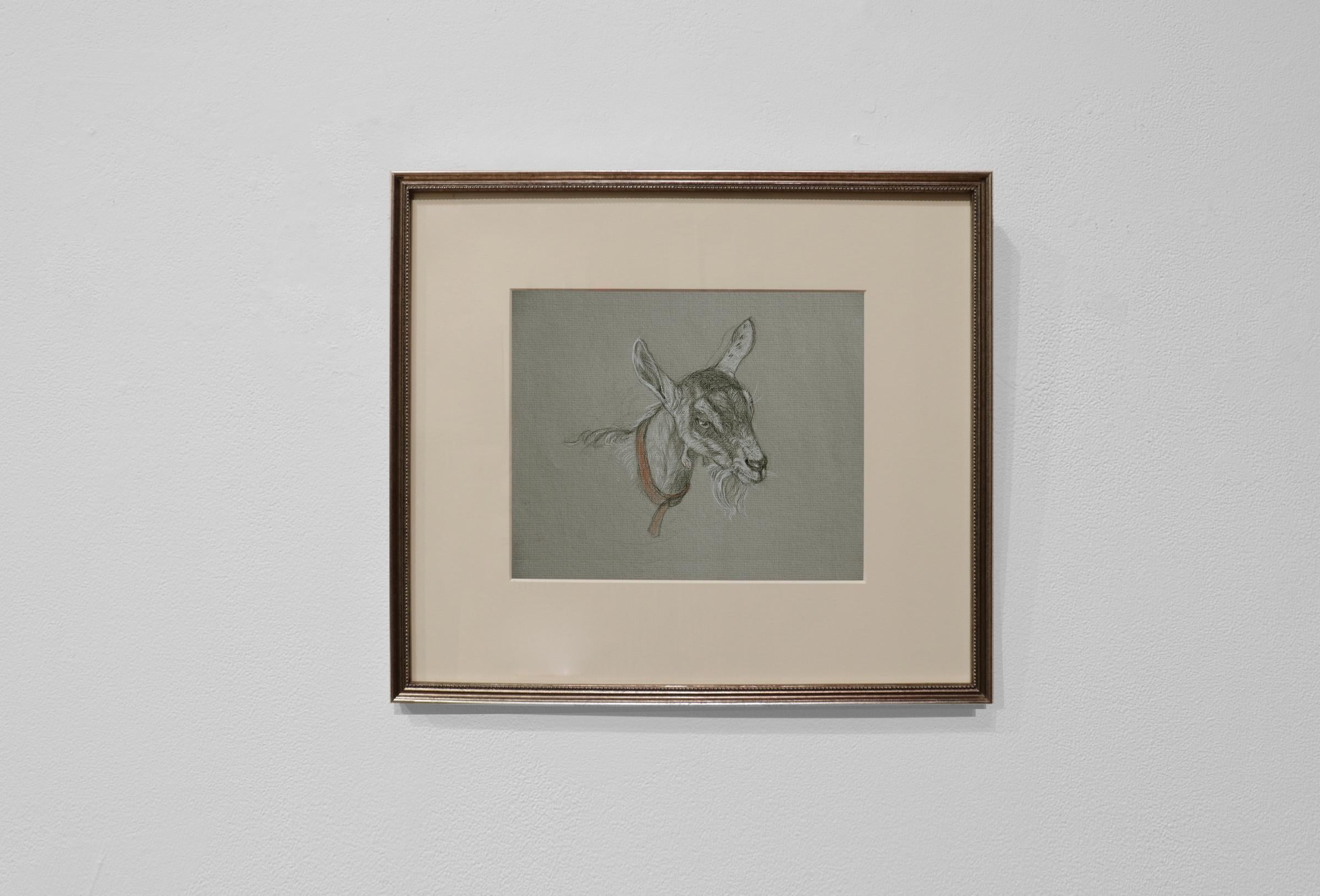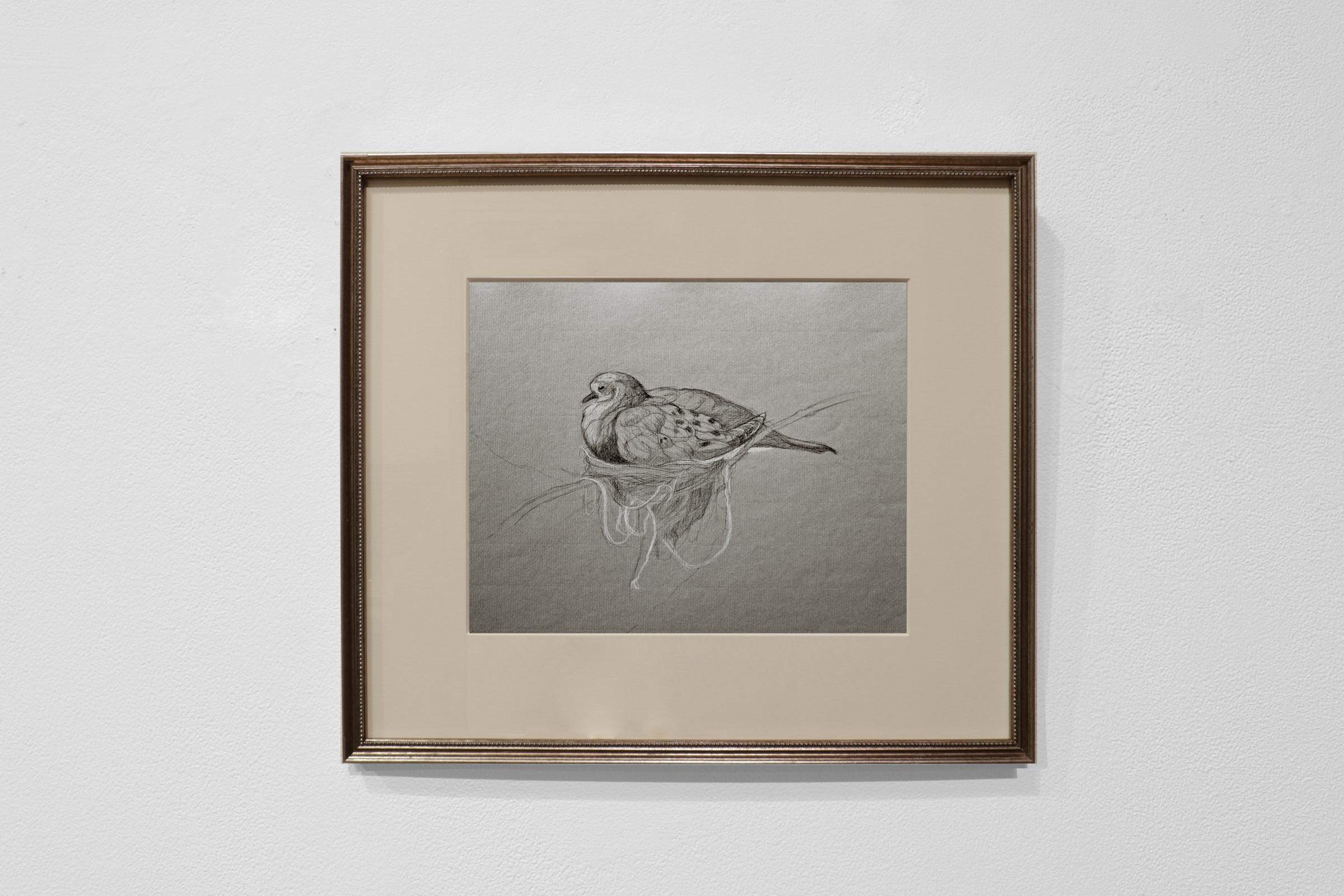Items Similar to Cat Studies, 20th Century British Animal Drawings
Want more images or videos?
Request additional images or videos from the seller
1 of 3
John SergeantCat Studies, 20th Century British Animal Drawings
About the Item
A collection of sketched by John Sergeant., priced individually.
Pastel and charcoal on Ingres paper
Image size: 7 1/2 x 10 1/2 inches (19 x 27 cm)
Mounted
Please note that dimensions vary slightly.
Notably, the eccentric nature of John Sergeant's character manifests itself within his compositions. Over the years he had perfected his style and technique, mostly using charcoal estompé on Ingres paper. He also used coloured pastels with small touches of Chinese white, as can be seen here in the Cat's whiskers.
Drawing was at the heart of all of his artistic practice. A friend once recalled an anecdote that out on a walk he came across Sergeant lying on the ground in a church yard. With the shards of an old tombstone around him Sergeant noted; 'excellent material to include in a drawing'.
- Creator:John Sergeant (1937 - 2010)
- Dimensions:Height: 7.5 in (19.05 cm)Width: 8 in (20.32 cm)
- More Editions & Sizes:Set of 6Price: $973
- Medium:
- Movement & Style:
- Period:
- Condition:
- Gallery Location:London, GB
- Reference Number:1stDibs: LU52412639252
John Sergeant
Sergeant was born in London, the son of a civil servant. His family soon moved to Faversham in Kent after they were bombed during World War II. He studied at Canterbury College of Art from 1954-57, during which period he met John Ward, who was to become a lifelong friend and supporter. In 1959 he entered the Royal Academy Schools, where he won a Drawing Prize in 1961. In 1962 he married a fellow student, Carolyn Cann. After graduating from the RA he taught part-time at art schools in Kent and worked on commissions including book jacket designs and illustrations and series of ‘room-portraits’ of interiors. He moved to near Builth Wells, Wales in 1983. In 1989 the Prince of Wales asked Sergeant to contribute drawings to his book Vision of Britain; two years later he accompanied the prince on an official visit to Prague. A superb draughtsman, he was a great exponent of the teaching of drawing in art school: “If you can draw you can paint. All you need to know as Whistler used to say, is which end of the brush to put in your mouth”. In his 2006 Colnaghi exhibition he described himself as a “serious serial draughtsman who explores, scrutinizes the same subject back, front, sideways, this way and that. It is all part of trying to understand”.
About the Seller
5.0
Gold Seller
These expertly vetted sellers are highly rated and consistently exceed customer expectations.
Established in 2007
1stDibs seller since 2014
66 sales on 1stDibs
Typical response time: 4 hours
- ShippingRetrieving quote...Ships From: London, United Kingdom
- Return PolicyA return for this item may be initiated within 14 days of delivery.
More From This SellerView All
- Girl Feeding Horse. Pen & Ink. Mid 20th CenturyBy Charles InderLocated in London, GBCharles Inder Flourished: 1920 - 1940 Girl Feeding Horse Ink on paper Image size: 6 x 8 cm Acid free incised mount and black frameCategory
20th Century Animal Drawings and Watercolors
MaterialsPaper, Ink
- Flying South, 20th Century British Artist, Gouache ArtworkBy Charles PaineLocated in London, GBCharles Paine 1895 - 1967 Flying South Gouache, signed lower right with monogram Image size: 2 ¾ × 2 ¾ inches Acid free mount and black frame £350Category
20th Century Animal Drawings and Watercolors
MaterialsGouache
- Portrait of a Man Wearing a Turban, 18th Century Pastel DrawingBy Thomas FryeLocated in London, GBPastel on paper Image size: 13 x 17 1/2 inches (33 x 44.5 cm) Mounted and framed This original pastel drawing by Thomas Frye is a half-length portrait of a man dressed in a turban. This drawing is the original sketch for one of the heads depicted in Frye's collection 'Twelve Mezzotint Prints' of 1760 and it can be assumed that this pastel work was created earlier of this same year. Two versions of the print, created from this original work, are currently held in the collection of the National Portrait Gallery and the Metropolitan Museum of Art. Frye's evocative figures, although presumably based on living models, exceed the conventions of portraiture, and also function as character studies. The man shown here - dressed in the fashionable 'Turkish' manner - turns with parted lips as if poised to speak, while raising the elegant fingers in one hand in a rhetorical gesture. His long eyelashes and smoothly rendered wrinkles and dimples are hallmarks of Frye's refined style. The Artist Thomas Frye (c. 1710 – 3 April 1762) was an Anglo-Irish artist, best known for his portraits in oil and pastel, including some miniatures and his early mezzotint engravings. He was also the patentee of the Bow porcelain factory, London, and claimed in his epitaph to be "the inventor and first manufacturer of porcelain in England," though his rivals at the Chelsea porcelain factory seem to have preceded him in bringing wares to market. The Bow porcelain works did not long survive Frye's death; their final auctions took place in May 1764. Frye was born at Edenderry, County Offaly, Ireland, in 1710; in his youth he went to London to practice as an artist. His earliest works are a pair of pastel portraits of boys...Category
1750s English School Portrait Drawings and Watercolors
MaterialsPaper, Oil Pastel
- Portrait of a Young Man Original Charcoal and Pastel French 18th CenturyLocated in London, GBFrench School 18th Century Portrait of a Young Man Charcoal and pastel on paper Image size: 11 x 7 inches Contemporary gilt frameCategory
18th Century Rococo Portrait Drawings and Watercolors
MaterialsPaper, Charcoal, Pastel
- Cirque Rancy, Signed and Dated 1913 English WatercolourLocated in London, GBWatercolour on paper, signed and dated '1913' lower right Image size: 10 x 14 1/2 inches (27 x 37 cm) Acid free mount At this time, Cirque Napoleon Rancy was one of the most prestigious and respected of French travelling shows. According to the corporate magazine Der Artist, Napoleon Rancy launched his two-masted marquee, 40 diameter, in 1910. In 1913 The Rixfords flying trapeze...Category
1910s English School Figurative Drawings and Watercolors
MaterialsPaper, Watercolor
- The Gaze, Signed Graphite 20th Century PortraitLocated in London, GBGraphite on paper, signed bottom right Image size: 13 x 8 3/4 inches (33 x 22.25 cm) Original frame Dora Thacher Clarke, later Dora Middleton, (1895–1989) was a British sculptor and wood carver who also wrote about, and promoted African art. Clarke was born in Harrow in Middlesex. Her father, Joseph Thacher Clarke was an American architect. Clarke won a scholarship that allowed her to attend the Slade School of Fine Art. Aged fifteen, Clarke initially studied at the Slade on a part-time basis for three days each week throughout 1910 and 1911 but during 1915 and 1916 she studied sculpture there as a full-time student. Clarke first exhibited at the Royal Academy in 1923 and continued to do so until 1959. In the early 1930s she was a regular exhibitor in group shows at the Goupil Gallery and in March 1937 had her first solo show at the French Gallery. She also exhibited at the Paris Salon and with the Royal Society of British Artists. Clarke's works included bronze castings, memorials and wood sculptures, often of African heads. For example she was commissioned to sculpt the posthumous portrait bust of Sir Walter Morley Fletcher. The most notable of her memorials is the panel and medallion tribute to Joseph Conrad at Bishopsbourne in Kent, which was unveiled in 1927. Clarke also wrote about, and promoted African art and spent a year, between 1927 and 1928 in Kenya, where she made many drawings which when she returned to London she used as the basis for wood carvings and bronzes of tribal figures. Wood carving became her technique of choice, often working with hardwoods and, on occasion, sperm whale teeth. Clarke married Admiral Gervase B Middleton in 1938 but rarely exhibited work under her married name. During World War II, Clarke was commissioned by the War Artists' Advisory Committee to produce a portrait medallion depicting a serviceman who had been awarded the George Cross. This proved to be the only portrait medallion acquired for the WAAC collection. Sculptures by Clarke are held in various museums, including the Ashmolean Museum which also holds a 1936 portrait of her by Orovida Camille Pissarro.Category
Mid-20th Century English School Portrait Drawings and Watercolors
MaterialsGraphite
You May Also Like
- Crouching Leopard drawing by British 20th Century artist Elsie Marian HendersonLocated in Petworth, West SussexElsie Marian Henderson (British, 1880-1967) Crouching Leopard Charcoal and pastel on paper 8 x 12.1/8 in. (20.3 x 30.8 cm.) Provenance: The estate of the artist Sally Hunter Fine Art, London Elsie Marian Henderson was born in Eastbourne in Sussex and with the encouragement of her mother, a keen amateur painter, she attended the South Kensington Schools before studying at the Slade School of Fine Art between 1903 and 1905. She continued her art education in Paris and in 1916, after returning to London she enrolled at the Chelsea Polytechnic, where she was taught lithography by the artist Francis Ernest Jackson...Category
20th Century English School Animal Drawings and Watercolors
MaterialsPaper, Charcoal, Pastel
- Moose Charcoal Painting by Richard Cockle Lucas 1878 English Signed 19th CenturyLocated in FRMoose Painting 19th Century 1878 English Signed by Artist Signed R Cockle 1878 Charcoal work Removed from its original frame Good with one fold and a f...Category
Late 19th Century English School Animal Drawings and Watercolors
MaterialsCharcoal, Paper
- GOAT WITH ORANGE COLLAR - Traditional Realism / Animal Drawing / Farm AnimalBy Patricia TraubLocated in New York, NYOriginal drawing by Patricia Traub.Category
2010s Contemporary Animal Drawings and Watercolors
MaterialsPaper, Graphite, Pastel, Charcoal, Chalk
- MOURNING DOVE AND NEST WITH WHITE STRING - Realism / Charcoal Drawing / WildlifeBy Patricia TraubLocated in New York, NYOriginal drawing by Patricia TraubCategory
2010s Contemporary Animal Drawings and Watercolors
MaterialsPaper, Chalk, Charcoal, Pastel, Graphite
- ICELANDIC GOOSE, REYKJAVIK, ICELAND - Traditional Realism /Contemporary WildlifeBy Patricia TraubLocated in New York, NYOriginal drawing by Patricia TraubCategory
Early 2000s Contemporary Animal Drawings and Watercolors
MaterialsPaper, Chalk, Charcoal, Pastel, Graphite
- Madiba’s Nguni Bull II - Mandela, Former South African President, Original ArtBy Nelson MandelaLocated in Knowle Lane, CranleighNelson Mandela, Madiba’s Nguni Bull II, Signed Original Artwork Many people are unaware that Nelson Mandela turned his hand to art in his 80's ...Category
Early 2000s Contemporary Animal Drawings and Watercolors
MaterialsCharcoal, Pastel
Recently Viewed
View AllMore Ways To Browse
Study Drawing
Old Vintage Drawing
Old Vintage Drawings
Heart Drawing
A Vintage Walk
Animal Mount
Vintage Nature Drawing
Vintage Drawings Of Animals
Charcoal Drawing Study
British China
20th Century Cat
Sketch Animals
Animal Sketches
Drawing Cats
20th Century Art On Paper British
Drawings Of Cats
British Sketch
Small Drawing Sketch





